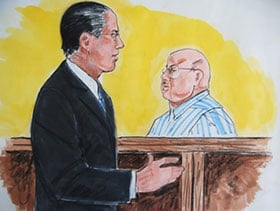In the previous blog post, we discussed the warrant requirement generally and some exceptions that have been applied over the years. In this post, we are looking at a relatively recent Supreme Court case that creates some significant limitations on warrantless entry in hot pursuit misdemeanor cases.
In the case of Lange v. California in 2021, Justice Elena Kagan’s opinion for the court changed the general rule of exigent circumstances in hot pursuit cases.
The facts of the case
In Lange, the defendant was driving with his radio extremely loud. The police officer followed him, turned on his police lights shortly before the defendant pulled into his driveway, and followed him into his garage while he was attempting to close the garage door.
Once inside the garage, the officer smelled alcohol and ultimately arrested the man and found that he was very drunk, his blood-alcohol content well beyond the legal limit.
Pretrial
Pretrial the defendant filed a motion to suppress evidence and quash arrest and argued that the officer’s entry into the garage was a violation of his Fourth Amendment right to be free from unreasonable search and seizure – that it was an illegal and unjustified warrantless entry. The lower court disagreed and allowed the warrantless entry as an exigent circumstance (hot pursuit) to justify a warrantless entry, Because the officer was pursuing the suspect, the officer was allowed to enter the home/garage in pursuit.
The Supreme Court’s ruling
According to Justice Kagan in the majority opinion, “The question presented here is whether the pursuit of a fleeing misdemeanor suspect…categorically…qualifies as an exigent circumstance.”
The Court determined that not every case involving hot pursuit creates a situation in which a warrant is unobtainable. Although many cases involve situations that justify warrantless entry, many cases do not. The determination, ruled the Court, should be made on a case-by-case basis. If an officer has the opportunity to obtain a warrant, the officer is obliged to do so, even if the officer is in hot pursuit of a suspect.
Some important nuances in the case
It is important to note that the initial crime for which the officer pursued the defendant was a noise violation, followed by the refusal to stop when the officer trailed the defendant and turned on his police lights.
These are misdemeanors, not particularly dangerous crimes or crimes suggesting serious emergency situations. The officer apparently did not suspect the defendant of driving under the influence at the time of the pursuit or the entry into the man’s garage.
A settled rule without settled results
Formerly, the courts have been divided on whether to apply a categorical rule or a case-by-case determination. A categorical rule would mean that the police always have an exception to the warrant requirement when pursuing a suspect into his or her home to complete an arrest based on conduct that began outside the home/property. A case-by-case determination would require examining each case to determine whether the officer had sufficient justification for abandoning the warrant requirement.
The Court ruled that police do not have a categorical exception to the warrant requirement when pursuing misdemeanants. These situations will be examined case by case to determine whether sufficient cause existed to enter without a warrant.
In the case of Lange, the Court sent the case back down to the lower courts to make that determination.
What this means for you
If you have been pursued into your home without a warrant, it could mean the evidence obtained upon entering your premises could be suppressed from evidence (thrown out) on account of an unjustified warrantless entry.
The ruling in Lange is limited to misdemeanor offenses, and it presents no guarantee that the evidence would be suppressed in all cases. Plenty of situations still exist that would justify a warrantless entry, even in misdemeanor situations. But under Lange, the police do not enjoy carte blanche to enter a fleeing suspect’s premises without a warrant.
This is important for anyone facing prosecution based on evidence found in hot pursuit of a misdemeanor crime suspect.
If you are charged with a crime after police entered your property, contact an experienced criminal defense lawyer who can protect your constitutional rights, prevent police abuse and fight to get the evidence against you suppressed.


